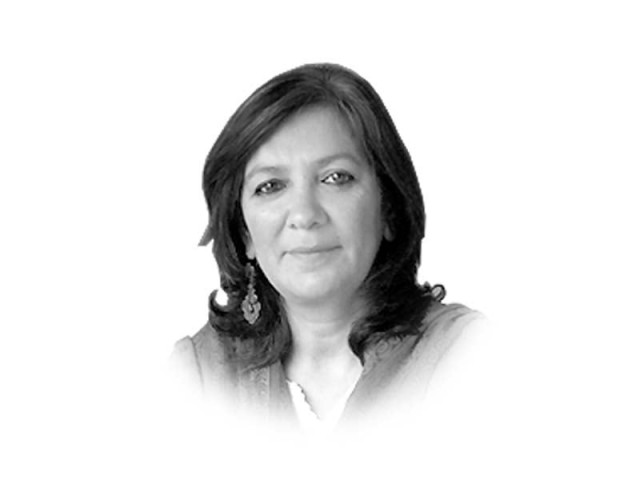On Holi and the return of Musharraf
The India-Pakistan universe changed in such subtle, fundamental ways that both countries won’t be the same again.

The writer is a consultant based in New
Delhi, where she writes for Business
Standard and blogs for The Times of India
In India, at least in the metros, all the elements of a traditional Holi were in full flow: the application of ‘gulal’, dry colour that easily washes off with water, ‘pakka rang’ or permanent colour that doesn’t, the eating of ‘gajiya’, really a flaky pastry dipped in ‘gur’ and concentrated sugar syrup, ‘bhang’ or marijuana-laced ‘thandai’, and much else.
Music was guaranteed by the professional ‘dholki wallah’, the do-it-yourself CD player or even off-key human singing, each of them spawning appreciative audiences. Amitabh Bacchhan’s eponymous ode to Cezanne’s “Bacchanalia — the Battle of Love”, “Rang barse” must have won, hands down, the vote for the most popular song in the Indian subcontinent on Holi.
Considering the movie in which it features, Silsila, is more than three decades old, clearly, there’s more to its popularity than Amitabh’s amazingly liquid voice. Fact is “Rang barse” is really a song that is embedded in the Braj, a language that is synonymous with the Hindi heartland around Mathura, Barsana and Vrindavan, barely 150 kilometres from Delhi. This is the cow belt that Krishna made famous with his mythological gambolling with Radha and countless other women, none of them his wives.
It is interesting, given the immensely patriarchal norms prevalent across north India, how people across ‘Brajbhoomi’ still greet each other with a ‘Radhey-Radhey’ instead of the ‘Ram-Ram’ that is much more common across the remaining Hindi heartland. This, of course, is a reference to Radha, amongst the first feminists in Hindu mythology, whose love for Krishna could not be confined to the love for her husband.
Several sociologists have, in fact, pointed out that the greeting of ‘Ram-Ram’ in north India, a reference to the god Rama is a reflection of the inequality between the sexes that prevails in that part of the country today.
Which is why Holi becomes the ultimate subversive festival, allowing women to come out of their homes in villages and mohallas and towns, and play Holi with men, both intimate and stranger. Everyone eats and drinks and dances and listens to music in the same space. For one blessed, anarchic day, Holi collapses the conventions and allows women to push back their ‘ghunghats’ and just have fun.
And so on Holi, Pervez Musharraf held his first press conference in four years in Karachi, and what a strange press conference it was. He was his own minder, picking who asked the question and choosing to answer it in his own way, ultimately a one-man show. Certainly not a grand recipe for political success.
The press conference was a measure of how much Pakistan had changed. There was no longer the apparent deference often on public view when Musharraf used to be president. Instead, a woman reporter asked the Kargil question and Musharraf went on to give the strangest answer: how he had seen his men cry when the Indian Army and the Indian government worked hand-in-glove with Bangladesh’s Mukti Bahini to break up Pakistan in 1971 and how a few years later, in 1984, he saw, with so much anger, how the Indians raced up the heights and took position on top of the Siachen glacier.
I am proud of the Kargil operation, Musharraf said, his jaw set obstinately. It left many of us in India half-stumped and half-amused at the incredible bravado we had almost forgotten was such an integral part of his psyche. Perhaps, Musharraf hasn’t heard of the ‘safe passage’ option being offered by the Indian government to former Kashmiri militants who now want to return home. Several are said to be tired of living in Pakistan, just across the Line of Control (LoC) and yearn for the apple orchards of home, as well as the innocence of their youth. According to the Omar Abdullah government in Jammu and Kashmir, about 370 former militants have already exercised this right and are back from Pakistan-held Kashmir.
The bitter truth is that Musharraf’s return to Pakistan opens old wounds and reiterates old prejudices. India cannot wish away Kargil in 1999 or the Mumbai attacks in 2006. For all the self-congratulatory euphoria over completing five years in power for the first time since it became independent, Pakistan’s political leaders must think deeply about the kind of country they want and how they want to locate it in a larger South Asia.
As for Dutt, the wheel of life seems to have taken an incredible turn, sending him to jail for five years for a crime that he admits to have committed and whose punishment he will now fulfil. Pakistan, said the Indian Supreme Court, masterminded the 1993 attacks, unusually naming a foreign country, as it handed down the judgement to Dutt and a host of other people.
Crying, with his sister Priya by his side, Dutt said he would not seek pardon just for himself, as that would be a moral travesty of the law. On the eve of Good Friday, Sanjay Dutt promised to atone for his sins. It now remains for India to forgive its once-errant son.
Published in The Express Tribune, April 1st, 2013.















COMMENTS
Comments are moderated and generally will be posted if they are on-topic and not abusive.
For more information, please see our Comments FAQ